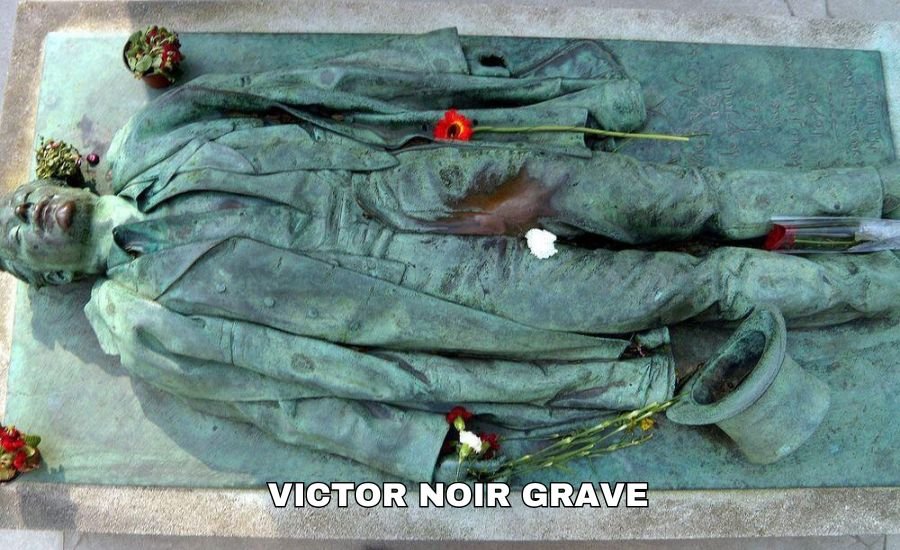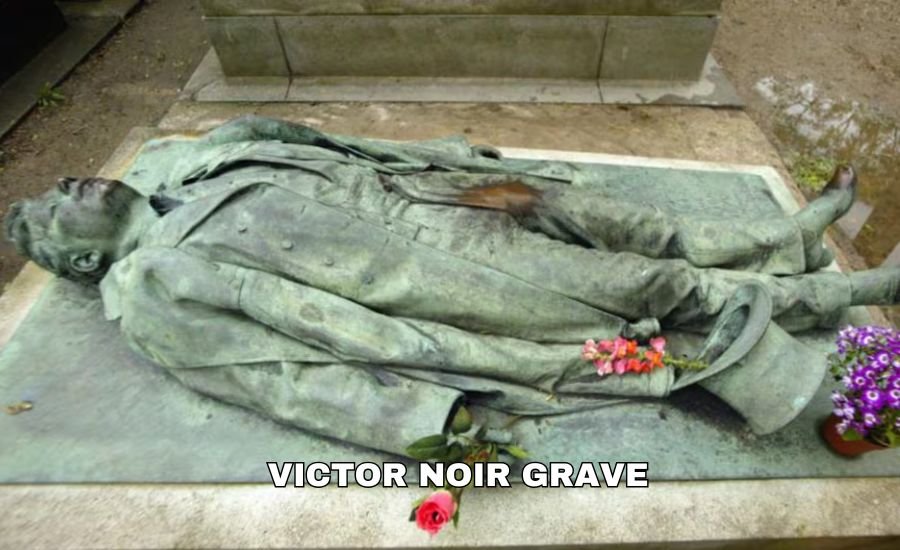In the sprawling, historic Père-Lachaise Cemetery of Paris, there lies a grave unlike any other—a site that has drawn curious tourists, hopeful romantics, and history buffs for over a century. This is the grave of Victor Noir, an ordinary journalist whose death sparked political upheaval and whose memorial has become a symbol of fertility and good fortune. But what makes the Victor Noir grave so famous? It’s a story of revolution, myth, and one sculptor’s artistic interpretation that transformed a tragedy into an enduring cultural phenomenon.
In this article, we’ll explore the life and death of Victor Noir, the myths that surround his grave, and why this bronze effigy has captured the imagination of millions.
Who Was Victor Noir? A Brief Biography
Victor Noir was born Yvan Salmon on July 30, 1848, in Attigny, a small town in the Lorraine region of France. Raised in a Jewish household, he later converted to Roman Catholicism. He adopted the pen name Victor Noir when he began working as a journalist. Despite his modest beginnings, Noir became a writer for La Marseillaise, a radical socialist newspaper that championed republican ideals in an era of imperial rule under Napoleon III.
At just 21 years old, Noir’s life was cut short, but his untimely death would catapult him into national fame and eventually transform him into a cultural icon.
The Duel That Led to Tragedy
The events leading to Noir’s death began with a heated feud between La Marseillaise and L’Avenir de la Corse, a pro-imperialist newspaper. Prince Pierre Bonaparte, a cousin of Emperor Napoleon III, took offense at articles published in La Marseillaise that criticized his family’s legacy. This culminated in Bonaparte penning a scathing letter challenging the editor, Paschal Grousset, to a duel.
As was customary at the time, Grousset sent two representatives, Victor Noir and Ulrich de Fonvieille, to negotiate the terms of the duel with Bonaparte. On January 10, 1870, the young men arrived at the Prince’s residence in Paris. Accounts differ on what transpired, but the confrontation quickly turned violent. Bonaparte fatally shot Victor Noir, claiming self-defense. However, witnesses, including Fonvieille, alleged that the Prince struck Noir first before pulling the trigger.
Noir’s murder ignited outrage across France. Over 100,000 people attended his funeral, and he became a symbol of resistance against imperial oppression. The incident fueled revolutionary sentiment, contributing to the eventual overthrow of Napoleon III’s regime later that year during the Franco-Prussian War.
Victor Noir Grave: The Birth of a Legend
In 1891, over two decades after Noir’s death, his remains were moved to Père-Lachaise Cemetery in Paris to honor his memory. Renowned sculptor Jules Dalou was commissioned to create a bronze statue commemorating the fallen journalist. The statue, depicting Noir as he lay after being shot, is both lifelike and haunting.
However, one detail of the sculpture has become its most infamous feature: a prominent bulge in Noir’s trousers. Whether intentional or accidental, this detail sparked rumors and gave rise to the myths that would make the Victor Noir grave one of the most visited in Père-Lachaise.
Read Also: Manuela-Escobar
The Fertility Myth of Victor Noir Grave
Over time, legends emerged linking the statue to fertility, love, and romantic fortune. Visitors began to believe that interacting with specific parts of the statue could bring them luck in matters of the heart or family. According to the myth:
- Kissing the statue’s lips is said to bring passion and romance.
- Touching the bulge in the trousers is believed to enhance fertility.
- Placing a flower in the hat by Noir’s side symbolizes gratitude or a wish for marital happiness.
Women seeking to conceive, find love, or reignite romance began flocking to the grave, performing these rituals. The result is visible to this day: the lips, groin, and shoes of the statue shine brightly, polished by countless hands and kisses, while the rest of the bronze bears the greenish patina of age.
Controversy Surrounding the Statue
The Victor Noir grave’s transformation into a fertility shrine has not been without controversy. In 2004, cemetery authorities installed a fence around the statue, citing concerns about wear and tear. A sign warned visitors against “indecent rubbing.” The move sparked widespread protests, particularly among women who viewed the statue as a symbol of empowerment and tradition. The fence was eventually removed, and the statue remains accessible to this day.
Père-Lachaise Cemetery: A Historical Context
Père-Lachaise Cemetery, established in 1804, is one of the most famous cemeteries in the world. Spanning 110 acres, it is the final resting place of numerous cultural icons, including Oscar Wilde, Jim Morrison, Edith Piaf, and Frédéric Chopin. Amidst this pantheon of legends, Victor Noir’s grave stands out for its unique blend of history, art, and mythology.
The Artistic Legacy of Jules Dalou

Jules Dalou’s statue of Victor Noir is a masterpiece of late 19th-century sculpture. Influenced by the Art Nouveau movement, the piece captures Noir’s humanity and vulnerability in death. While the statue’s bulge has garnered the most attention, it’s worth appreciating Dalou’s skill in rendering the details of Noir’s clothing, facial expression, and even his fallen hat.
The artistic merit of the statue ensures that it remains significant beyond its mythical associations.
Why Victor Noir Grave Continues to Fascinate
The ongoing allure of Victor Noir’s grave can be attributed to several factors:
- Historical Significance: Noir’s death is a poignant reminder of the struggles for press freedom and democratic ideals.
- Cultural Myths: The fertility legends surrounding the grave have transformed it into a site of personal pilgrimage.
- Artistic Value: Dalou’s sculpture is a stunning example of how art can immortalize history.
Visiting the Victor Noir Grave
If you’re planning a visit to Père-Lachaise Cemetery, here’s what you need to know:
- Location: Division 92, GPS Coordinates: 48.8611298, 2.3964601.
- Best Time to Visit: Early morning or late afternoon to avoid crowds.
- What to Bring: Flowers for the hat if you wish to participate in the tradition, and a camera to capture the beauty of the site.
Conclusion: The Enduring Mystique of Victor Noir Grave
Victor Noir’s story is one of tragedy, art, and unexpected fame. From his untimely death as a journalist to his transformation into a symbol of fertility and love, his grave continues to captivate and inspire. Whether you’re drawn by the myths, the history, or the artistry, a visit to the Victor Noir grave is an unforgettable experience.
This iconic monument reminds us of the power of storytelling, the significance of art, and the enduring human quest for connection—be it with history, love, or hope.
FAQs
Q: Who was Victor Noir?
A: Victor Noir was a French journalist whose death in 1870 became a symbol of resistance against the imperial regime of Napoleon III.
Q: Why is Victor Noir’s grave famous?
A: The grave is famous for its bronze statue, which has a noticeable bulge in the trousers, sparking myths about fertility and romantic luck.
Q: Where is Victor Noir’s grave located?
A: His grave is in Père-Lachaise Cemetery in Paris, in Division 92.
Q: What is the fertility myth surrounding the grave?
A: It is believed that kissing the statue’s lips, touching the bulge, or placing a flower in the hat can enhance fertility, bring love, or ensure a happy marriage.
Q: Can visitors still touch the statue?
A: Yes, visitors can touch the statue as a fence installed in 2004 was removed after public protests.
Stay informed with the latest news and updates on Techi Boomb
